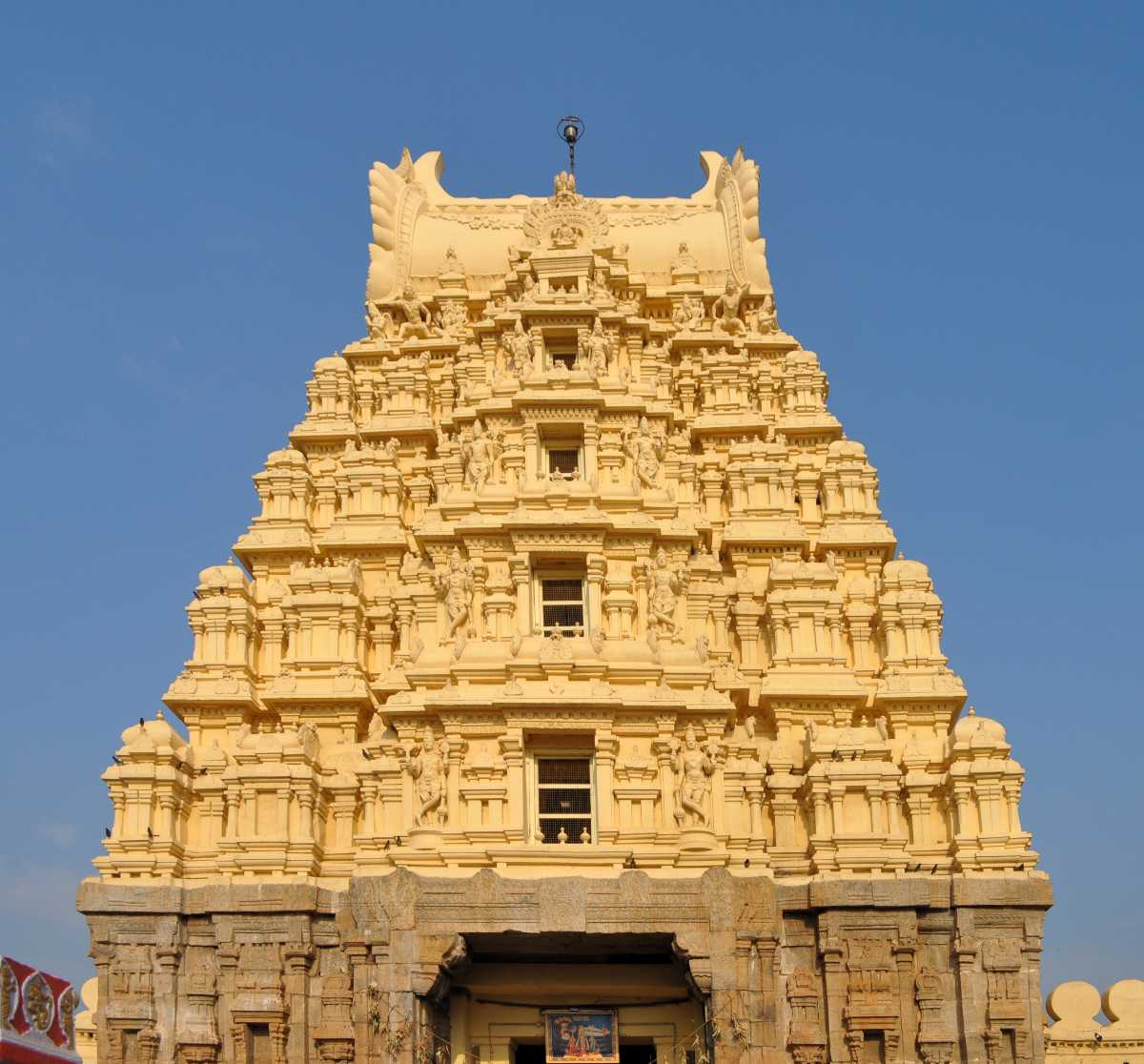Sri Ranganathaswamy Temple
Tags : Temple
Timings : 7:30 AM - 1:00 PM, 4:00 PM - 8:00 PM
Time Required : 2-3 hrs
Entry Fee : General Entry: Free,
Quick Darshan: INR 250,
Vishwaroopa Seva: INR 50
Dress Code : Nothing Specific. Modest attire where the visitor is decently covered.
Sri Ranganathaswamy Temple, Srirangapatna Overview
Ranganathaswamy Temple, a beautifully carved temple complex, is located in Srirangapatna in the south-western state of Karnataka, India. The temple is dedicated to Lord Ranganatha who is an avatar of Lord Vishnu in Hindu religion. Do take a minute to notice the beautiful carvings at the entrance Gopuram of the temple. The complex is surrounded by the River Kaveri which adds to the beauty of the temple. The ghats of the river are frequented for taking a dip before entering the holy temple complex.
In Hinduism, the Sri Ranganathaswamy Temple in Srirangapatna is considered as one of the five most important and sacred shrines devoted to Lord Vishnu. These sites are called Pancharanga Kshetram and are of very high religious importance. The presiding deity of this temple is the Adi Ranga, or the 'first Ranga'. The temple has a rich history associated with it and is visited by devotees from all over the world. It comes under the Archaeological Survey of India.
The idol of Lord Ranganatha is seen in a reclining posture over the Sheshanaga. An inscription in the temple premises indicates that the shrine was first sanctified around 984 AD. Innumerable architectural intricacies make the Sri Ranganathaswamy Temple an enthralling architectural marvel and must be included on your list of places to visit.
Read More on Sri Ranganathaswamy Temple
History of Sri Ranganathaswamy Temple
Around 1210 AD, King Veera Ballala II of Hoysala Dynasty made some additions and renovations to the temple complex. These have been documented in various inscriptions on the structure. The structure also possesses intricate carvings signifying architecture of Vijayanagara Dynasty and the Mysore Kingdom (Wodeyar Kings).
Architecture of Sri Ranganathaswamy Temple

The Mukhamandapa is adorned with intricately carved miniature Shikharas (towers) that look like a garland. These miniature towers have fine stucco work images of Lord Vishnu. The main shrine possesses the divine idol of Lord Vishnu resting or reclining on the coils of the Adishesha Naag with its seven hoods canopying the Lords idol. Goddess Lakshmi is seen at his feet while idols of some other deities are seen around the Idol of Lord Vishnu. There are also some smaller shrines inside the temple complex that are dedicated to Srinivasa, Gopalakrishna, Narasimha, Garuda and Hanuman.
Celebrations at Sri Ranganathaswamy Temple
2. Sriranga Jayanti: The Jayanti is celebrated on the seventh day of the Vaishakh Shuddhi. It is the day Idol of Sri Ranganathaswamy was installed here.
3. Uyyalotsava: Uyyalotsava is a five-day festival that starts on Prathama Ekadashi in the Hindu month of Ashadi and is completely dedicated to Sri Ranganathswamy. The sixth and the seventh day are dedicated to Goddess Ranganayaki and Lord Krishna respectively.
4. Vedantacharya Thirunakshatra: This festival involves special poojas performed for eleven days in either in the Hindu month of Ashwin or Bhadrapada. After the eleven days of poojas, the Gandhapudi Festival is celebrated with great enthusiasm.
5. Navaratri: During these festivals, special poojas, homas, Yaggyas etc. are performed for 9 days. The Shuddha Padya in the Hindu month of Ashwin marks the first day of the festival. A procession of Sri Ranganathaswamy is taken on the main roads on the day of Ayudha Pooja day and on the last day, Vijayadashami day; the festival is concluded by performing pooja for the Shammi tree in front of the temple.
6. Bangarada Garudotsava: It is celebrated on the full moon day in the Hindu month of Vaishakh. The gold plated idol of Garuda in the temple complex is decorated with flowers, and a procession is taken on the main roads with the Idol of Sri Ranganathaswamy sitting on the Idol of Garuda.
7. Ashta Teerthotsava: It is believed that a dip or a bath in the eight holy streams of River Kaveri on Dashami, the tenth day of the Hindu month of Ashwin before offering prayers to Sri Ranganathaswamy. This day is marked as the Ashta Teerthotsava. This festival also includes a procession of the idol of Sri Ranganathaswamy.
Sri Ranganathaswamy Temple Seva
Kunkum Archane: INR 10
Saharanam Archane: INR 10
Vastra Kanike: INR 20
Nagha Kanike: INR 20
Nivedana Kanike: INR 20
Shikyothsava: INR 50
Adyanosava: INR 50
Vasanthosava: INR 80
Rangamuddi Mantaposava: INR 100
Sannidhimantapothsava: INR 100
Rathosavada Mantaposava: INR 100
Prakarotsava: INR 100
Suttlagudi Abhisheka: INR 100
Chaturveedi Utsav: INR 150
Utsavara Abhisheka - INR 200.00
Ammanavara Abhisheka: INR 200
Muladevara Abhisheka: INR 1000
Best Time To Visit Sri Ranganathaswamy Temple
Tips For Visiting Sri Ranganathaswamy Temple
2. The temple is visited by devotees all through the year, and there are long lines almost every day, but the temple gets extremely crowded during the weekends.
3. Garlands, flowers and other offerings can be bought from the kiosks outside the temple complex.
4. Carry enough water to keep yourself hydrated.
5. Mobile phones and cameras are not allowed inside the temple complex.
6. A decently large area nearby is used as parking space. Visitors can park their vehicles at minimal charges.
How To Reach Sri Ranganathaswamy Temple
The Srirangapatna Railway Station is just behind the temple complex. Devotees can walk from the station to the temple.
